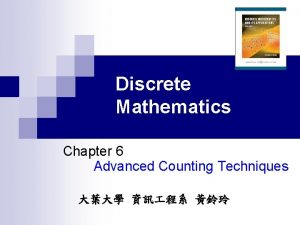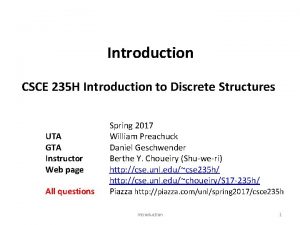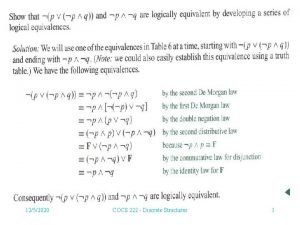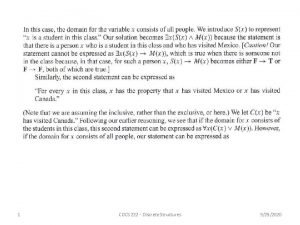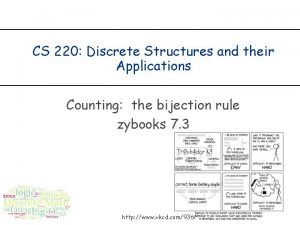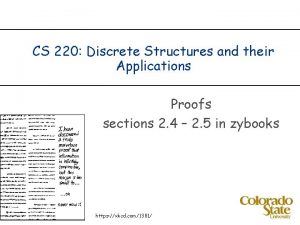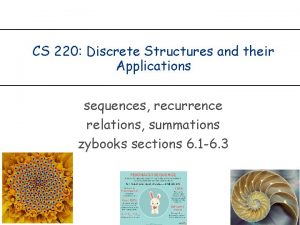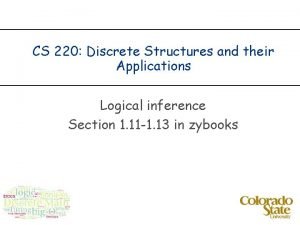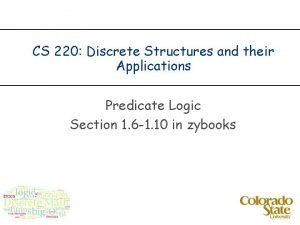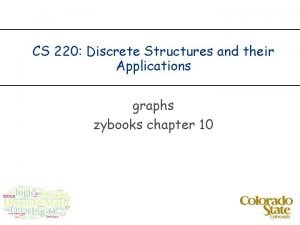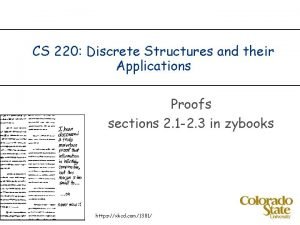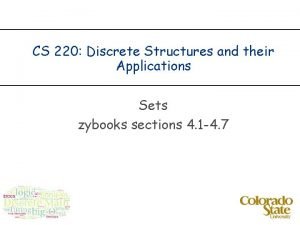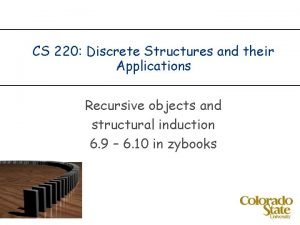CS 220 Discrete Structures and their Applications Counting










- Slides: 10

CS 220: Discrete Structures and their Applications Counting: the bijection rule zybooks 7. 3 http: //www. xkcd. com/936/

counting subsets Show that the number of different subsets of a finite set X is 2|X|

counting subsets Show that the number of different subsets of a finite set X is 2|X| The correspondence between subsets and bit strings is a bijection

the bijection rule The bijection rule Let S and T be two finite sets. If there is a bijection from S to T, then |S| = |T|.

the bijection rule The bijection rule Let S and T be two finite sets. If there is a bijection from S to T, then |S| = |T|. Example: Suppose that every person in a theater must submit a ticket to an usher in order to enter. One way to count the number of people in theater is to count the number of tickets submitted.

counting palindromes If x is a string, then x. R is the reverse of the string. For example, if x = 1011, then x. R = 1101. A string x is a palindrome if x = x. R. Let B = {0, 1}. The set Bn is the set of all length n bit strings. Let Pn be the set of all strings in Bn that are palindromes. (a) Show a bijection between P 6 and B 3. (b) What is |P 6|? (c) Determine the cardinality of P 7 by showing a bijection between P 7 and Bn for some n.

the k-to-1 rule A group of kids at a slumber party all leave their shoes in a big pile at the door. How to count the kids? Count the shoes and divide by two. This assumes a well defined function that maps each shoe to the kid who owns it. This is an example of a k-to-1 correspondence: Let X and Y be finite sets. A function f: X→Y is a k-to-1 correspondence if for every y ∈ Y, there are exactly k different x ∈ X such that f(x) = y.

the k-to-1 rule Let X and Y be finite sets. A function f: X→Y is a k-to-1 correspondence if for every y ∈ Y, there are exactly k different x ∈ X such that f(x) = y. The k-to-1 rule. Suppose there is a k-to-1 correspondence from a finite set A to a finite set B. Then |B| = |A|/k

example Ten kids line up for recess: {Abe, Ben, Cam, Don, Eli, Fran, Gene, Hal, Ike, Jan}. Let S be the set of all possible ways to line up the kids. For example, one ordering might be: (Fran, Gene, Hal, Jan, Abe, Don, Cam, Eli, Ike, Ben) Let T be the set of all possible ways to line up the kids in which Gene is ahead of Don. Note that Gene does not have to be immediately ahead of Don. It's easy to count |S|. Computing |T| is harder.

example Ten kids line up for recess: {Abe, Ben, Cam, Don, Eli, Fran, Gene, Hal, Ike, Jan}. Let S be the set of all possible ways to line up the kids. For example, one ordering might be: (Fran, Gene, Hal, Jan, Abe, Don, Cam, Eli, Ike, Ben) Let T be the set of all possible ways to line up the kids in which Gene is ahead of Don. Note that Gene does not have to be immediately ahead of Don. Define a function f whose domain is S and whose target is T. Let x be an element of S, so x is one possible way to order the kids. If Gene is ahead of Don in the ordering x, then f(x) = x. If Don is ahead of Gene in x, then f(x) is the ordering that is the same as x, except that Don and Gene have swapped places. What does this tell us about |T| ?

